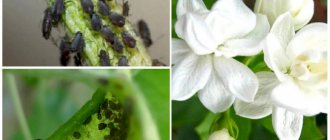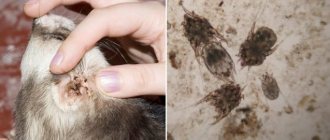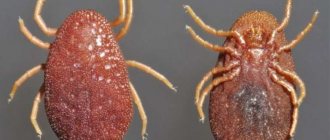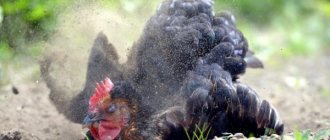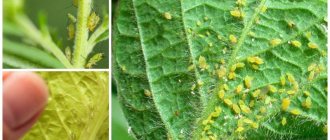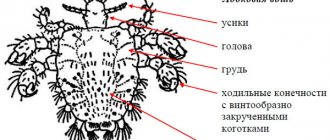One of the most common and dangerous pests on indoor lemons and tangerines is aphids. It most often affects the plant during the period of active growth of young shoots, settling on them and quickly sucking the juice out of them. By doing this, it slows down its development; you can also observe that citrus leaves dry out and fall off, and young shoots dry out. In addition, aphids on indoor plants are dangerous carriers of various viral diseases that can lead to their death.
Appearance of aphids on a young shoot
Aphids on home lemons are usually a small insect, about 0.5 millimeters, light green, with a hue that blends in with the young shoots. Larvae are lighter in color, adults are darker. Because of this color, it is difficult to immediately notice and take appropriate measures. This insect reproduces incredibly quickly; 15-25 generations can be born in less than a season.
Aphid on a plant leaf
In the earliest stage of aphid infestation, this insect can be seen on the back of young leaves, on the ovary. If you see at least one such representative on a lemon and you have a suspicion that aphids live on the lemon, there should be no questions about how to get rid of it, you should take action immediately.
Adult aphids lay eggs in large numbers
Diseases of lemons indoors
Indoor lemon has a fairly large list of possible diseases. Let's look at the most common ones.
Chlorosis
This disease occurs as a result of stagnation of moisture, acidification of the soil, deficiency of iron and other elements. In this case, there is a decrease in the activity of photosynthesis and the formation of chlorophyll. The first sign is yellowing of the leaves and then their falling off. Then the tops of the shoots may dry out, the roots die, and the leaves become shredded.
With chlorosis, the soft tissues of the leaves turn yellow, but the veins remain green.
It is clear that the disease is caused by a violation of care, so first of all you need to eliminate them:
- Get rid of stagnant moisture, dry the soil, and replace it if necessary. Rinse and dry the drainage. You may need to transplant it into another, smaller pot.
- Test the acidity of the soil using litmus paper. If it is high, then the soil should be deoxidized by adding fluff lime or chalk. To do this, take half a tablespoon of powder and dilute it in a glass of warm water, then water the soil in the pot. The acidity of the water flowing from the drainage holes is measured, and if it is still high, the procedure is repeated until the pH level is within 6-6.5 units.
- Replenish iron deficiency by adding preparations containing it in chelated form, such as Ferrofit, Ferrilen, Antichlorosis, Micro-Fe and the like. Or you can simply dissolve 20-40 grams of iron sulfate in one liter of water and feed the plant.
Phyllosticosis
This fungal disease is also called brown spot. A sign of the disease is the formation of brown or dark brown spots of round, oval or irregular shape on the leaves. If treatment is not started, the spots grow and cover the entire surface of the leaf blade, after which the leaves dry out and fall off. Favorable conditions for the development of fungus are dampness and air temperature of +25 °C and above. The source of infection is soil, water, purchased flowers, etc.
When affected by phyllosticosis, brown spots form on the leaves of plants
To cure a plant, you should tear off the affected leaves and treat the crown with fungicides (these are drugs to combat fungal diseases). Popular drugs are Horus, Quadris, Abica-Peak and others. It is better to use them outdoors, but if you still have to use them indoors, then take precautions - prevent the drugs from getting on food or dishes, and ventilate the room after treatment. If the infection is not severe, then it is better to use biological products such as Fitosporin-M, which is absolutely safe for humans, animals and bees. At the same time, it is also a fertilizer, as it contains humic acids.
Anthracnose
This is also a fungal disease that often affects lemons in greenhouses and conservatories. If the room has high humidity and temperature, then indoor lemon may also become infected. Anthracnose can be recognized by the formation of dark brown spots on the leaves, covering the edges. If the infection is severe, the fungus spreads to the shoots and fruits, all leaves dry out, and the above-ground part of the plant dies.
Anthracnose can be recognized by the formation of dark brown spots on the leaves, covering the edges
Prevention and treatment are the same as for other fungal diseases.
Citrus cancer
If dark brown spots with a yellow border, similar to small tumors, have formed on the leaves of the lemon, this means that the plant is infected with the citrus canker virus. It is not able to cause harm to a healthy plant, but if it is weakened by other diseases or poor quality care, then cancer will begin to develop. At the same time, it, starting on the leaves, will subsequently move to the fruits and shoots. We have not yet learned how to fight the disease, so the plant will definitely die. Without expecting this, it is destroyed as quickly as possible so as not to infect healthy lemons and other citrus fruits, if any. Prevention - careful adherence to the rules of lemon care, as well as regular treatment of the crown with a weak solution of potassium permanganate at intervals of 3 months.
If dark brown spots with a yellow border appear on the leaves of the lemon, the plant is infected with the citrus canker virus.
Video: lemon diseases
Prevention and home remedies
All mites do not tolerate moist air well, so frequent spraying and periodic warm showers for plants are a good preventative measure. Timely removal of faded buds and old yellowed leaves may be useful. Mite eggs can retain live larvae for five years, so even with the apparent complete destruction of pests, there is always a risk that they will infect a plant or a collection of crops. Therefore, it makes sense to monitor the sterility of the soil when replanting a flower or washing its roots.
Another, albeit indirect, method of prevention is healthy plants with strong immunity.
Conditions suitable for lemon, sufficient lighting, timely replanting and pruning, periodic spraying with stimulants (Epin) will ensure that pests, even if they exist, will not be able to cause significant harm to the plant simply because the walls of the vessels are strong, elastic and quickly regenerated. Temporary or long-term violation of care conditions (withered leaves, heat, dryness, draft) - and mites quickly occupy the weakened plant.
It is not always possible to use strong drugs at home, for example, there may be children in the house or it is not possible to ventilate the room well. Please note: no “home” method can guarantee complete destruction, since the mites are very small. The following will help to partially cope with the pest on the lemon tree:
- Medical alcohol 96%. It will only get rid of adult pests; eggs cannot be destroyed, but with regular treatment it is possible to reduce the pest population. It evaporates quickly, so it does not damage the green mass, but it is not suitable for plants with thin leaves (lemon leaves are quite dense).
- Green soap. This is a special substance, environmentally friendly and completely safe for plants. Dilute soap in a proportion of 200 g (4 tbsp) per 10 liters of water. It is necessary to carefully spray the lemon tree with the resulting solution, paying special attention to the nodes, the underside of the leaves, and the axils. When processing, the pot should be covered with film, since soap, when it gets into the soil, disrupts its acidity.
- Laundry soap. Use a sponge to whip up foam and apply to leaves and branches. Leave for 3-4 hours, the soap will dry, forming a film. It is not very well tolerated by the plant itself, so the soap should be washed off, and the still wet flower should be wrapped in film and left overnight. The next morning you need to let the plant breathe and then repeat the procedure. This sequence is repeated at least three times. It is advisable that soapy water does not get on the ground, although spraying the surface layer cannot harm the roots. You should absolutely not spill soapy water on a clod of soil; most likely, the lemon will die.
- Dishwashing liquid. Effects on pests no worse than soap. It is advisable to take a product for treating children's accessories. The procedure is similar to that described above. In any case, if you wash the leaves of the plant, this will remove more than half of all mites. Be sure to disinfect the pot and the place where the plant stood.
- Garlic infusion and onion juice. Due to the characteristic odor, they are rarely used. The garlic infusion is prepared as follows: chop 2 heads of the vegetable, add 1 liter of water, leave for a week. The resulting infusion is diluted with water 2 times and the affected leaves are wiped.
Pests on lemon
Of course, in indoor conditions it is more difficult for insects to get to the plant, but there are still ways.
Shchitovka
This is a hemiptera insect with a small (0.5-5 mm) body covered with a dense shield consisting of one or two larval skins and a secretory waxy part. Because of this, scale insects on the plant are sometimes perceived as droplets of wax. Young insects move actively, settling throughout the lemon. In adulthood, scale insects lose the ability to move and stick to the plant. Feeding on its juice, they themselves secrete a sweet liquid, which accumulates on the leaves and shoots, making them sticky. It clogs pores, preventing respiration and photosynthesis. This liquid is also a breeding ground for sooty fungus. If you do not fight the pest, the result will be disastrous - the leaves will curl, dry out and fall off, the plant will weaken and die.
Scale insects on the leaves resemble droplets of wax
Insecticides are used to kill pests. The contact preparation Fitoverm can be used against young larvae, but adult insects are reliably protected from its damaging effects by the shell. Therefore, systemic drugs that penetrate the plant’s vascular system will be more effective. Pests, feeding on poisoned juice, die. The best of this group for lemon are Aktara and Aktellik. They can not only spray the crown, but also water the soil to enhance the effect. But it should be remembered that Actellik has a strong unpleasant odor, so it can only be used outdoors. In addition, you can use various folk remedies - onion and garlic infusions (they are prepared by keeping chopped vegetables in water for about half a day at the rate of 50 grams per half liter), soap-kerosene solution (per liter of water 40 grams of grated soap and 1 ml kerosene) and others. In the initial stages of insect damage, you can wash off with soapy water using a brush or sponge.
Aphid
The smallest (0.5-3 mm) insect is widely known to everyone who has a garden, vegetable garden or indoor plants. As a rule, light green aphids can be found on lemons. Its harmful effect is similar to that of the scale insect - the aphid also feeds on the sap of leaves and shoots, secretes a sticky sweet liquid, and curls the leaves. The means and methods of dealing with it are also similar.
Light green aphids are more common on lemons.
Spider mite
This pest has microscopic dimensions (0.2-0.6 mm), and is not easy to see with the naked eye. Therefore, it is usually possible to detect its presence on a lemon only after some part of the leaves is damaged. Settling on the underside of the leaf, these arthropod arachnids pierce the leaf blade and feed on the sap. On the front side of the leaf, yellow spots form around the punctures, which are used to determine the presence of a mite. Subsequently, the leaves curl into irregularly shaped lumps, which the mite entangles in a web, thus equipping a nest.
Very small yellowish dots on the leaves indicate damage by spider mites
Insecticides are powerless against ticks. They are fought with acaricides (these are special anti-tick preparations) and universal insectoacaricides, for example, the above-mentioned Fitoverm and Actellik. In indoor conditions, Demitan is used, which successfully copes with the parasite, but it is dangerous for fish, so you should protect the aquariums in the house from getting into them.
Mealybug (white aphid, hairy louse)
It is small in size (from 3 to 6 mm) and has an oblong body, covered with a powdery, cotton-like white coating. Like the previous pests discussed, it is sucking and feeds on sap from all parts of the plant. A variety of citrus mealybug can also attack lemon roots. It's very easy to get rid of it. Since the bug is afraid of moisture, when it is detected, it is enough to simply bathe the lemon in warm soapy water, thoroughly washing off the insects. Then you should treat the crown with a strong-smelling infusion, for example, tobacco or garlic, to repel new pests.
The mealybug has an oblong body covered with a mealy, cotton-like white coating.
Video: Aktara treatment for pests
Signs and consequences of infection
In the early stages of infection, while the spider mite has not yet entangled the plant in its web, it can be detected with a magnifying glass. You need to spread white paper under the lemon leaves and gently shake the tree. Fallen pests can be examined under a magnifying glass. You can suspect the appearance of a parasite on citrus fruits by the following signs: yellowing and drying of leaves, cobwebs on one side of the leaves, in which new parasites are hatched.
You can also soak a cotton swab in alcohol and wipe the leaves of the plant. If there is a pest, it will be visible on the cotton wool.
Some Frequently Asked Questions About Lemon
It is not always possible to determine the cause of deviations in the development of lemon. Let's answer some common questions about diagnosing problems.
Brown spots appeared on the lemon
This indicates infection with fungal diseases - anthracnose or phyllosticosis. In the worst case scenario, it could be citrus canker.
Why does a lemon drop flowers and what to do?
The reasons for this phenomenon may be various violations of lemon agricultural technology:
- Drafts and sudden changes in temperature during flowering.
- Moisture deficiency or excess.
- Inadequate nutrition, deficiency of potassium and phosphorus.
- Too much flowering, the plant sheds excess flowers.
- Moving a blooming lemon to other rooms, turning it 90-180°.
- Pest infestation.
To eliminate the problem, you need to normalize the living conditions, normalize by removing excess flowers (leave one of the largest buds per 10-15 leaves), and get rid of pests.
How can you treat lemon when rolling leaves?
To answer this question, you need to know the causes of the phenomenon. They can be like this:
- Leaves may curl due to lack of water. You should follow the rules for maintaining optimal humidity for lemon.
- If there is a lack of fresh air, the leaves can also curl. Therefore, with the onset of warm days, indoor plants should be moved to verandas or under awnings and similar places, protected from drafts and direct rays of the sun.
- If after watering the leaves do not straighten and the situation remains unchanged, this means that the plant is deficient in boron. In this case, you need to make up for the deficiency by adding a 0.2% solution of boric acid (2 g per liter of water).
- If the leaves are not rolled into a tube, but simply bent, then this indicates a copper deficiency. For such symptoms, you need to spray the lemon with a 0.5% solution of copper sulfate.
- And the leaves can curl as a result of damage by aphids or scale insects.
Why do lemon leaves have sticky leaves?
The most common cause is the sweetish secretions of aphids or scale insects. And also, perhaps, with excessive watering, the plant itself releases a sugary liquid.
Fighting various types of ticks
There are several varieties of mites that damage plants. You should know that all of them are not insects, they belong to the order of spiders, so remedies against the former may not work. The common spider mite most often lives on indoor plants - this pest is omnivorous, affecting both citrus fruits and roses, dracaenas, fuchsias, and palm trees.
On citrus fruits there is also the Atlantic spider mite, which, in addition to lemons and tangerines, loves palm trees, and the red spider mite, which settles on callas, orchids and nightshades. The latter variety is very prolific, and the higher the air temperature, the more actively it lays eggs. In the cold it hardly reproduces. Can't stand cold showers. The Atlantic pest is characterized by increased resistance and is very tenacious even in high humidity, which other varieties do not like.
In addition to them, you can find the cactus flat mite or the red flat mite. These varieties are almost insensitive to treating the plant with a soap solution, although this reduces their population size. Parasites are destroyed using:
- insecticides;
- irradiating the plant with a UV lamp;
- pyrethrum infusion (2-3 g per 1 liter of water).
Preventing the appearance of midges
To prevent the appearance of midges, you need to use a special soil that contains components that are not suitable for eating by larvae. The following can be used as additives to the soil base for these purposes:
Special soil with additives against plant diseases
- coal;
- bark;
- coconut fiber;
- peat (fibrous);
- needles.
Before use, the soil must first be frozen so that any larvae that accidentally enter the soil will die before the lemon appears in the pot. You should not use organic fertilizers that are susceptible to rotting (for example, tea leaves). Such additives stimulate the maturation of midge larvae, which cause the greatest harm to the plant.
Since midges can severely damage roots, it is necessary to check and treat them if midge damage is suspected. To do this, you need to clean and dry the root of the plant, and then replant it in fresh soil, limiting watering.
When watering, to eliminate earthen midges, add a solution of potassium permanganate to the water for irrigation. The main condition for its successful use is accuracy and dosage. An excess of manganese in the soil can cause the plant to wilt.
Adding potassium permanganate to water for watering plants
Do not allow excess moisture in the soil. Excessive moisture causes the appearance of midges. A good preventative measure is to periodically loosen the soil in order to dry the soil from excess moisture.
Special Precautions
Since lemon is too attractive to insect infestations, when purchasing new plants, it is necessary to isolate them from the lemon tree. Insects in the soil or on a new plant can easily end up on a vulnerable lemon. They have every opportunity for this. And if this happens, you will have to immediately begin fighting new pests.
Growing lemon separately from other plants will protect it from pests.
By taking preventive measures and using available insect control products, you can protect your homemade lemon and extend its life.
Folk ways to combat spider mites
Due to their high toxicity, the chemicals are dangerous to use at home. Traditional recipes show good results in the initial stage and with a low level of infection. To get rid of spider mites on indoor lemons, you need regular procedures.
Plants are neighbors
Geranium is a popular flower that is often grown at home. To prevent pests from appearing on the lemon, you need to place a pot next to it with a fragrant neighbor. The plant emits a specific aroma that repels spider mites. Insects do not like the smell of garlic.
Rosemary essential oil
The fragrance of the oil concentrate is unpleasant for the dangerous pest. Add 10 drops of the drug to a liter of warm water and pour into a spray bottle. Every day, the lemon crown is generously sprayed with liquid until the signs disappear. During hot periods, place a bowl with an aromatic solution next to the plant.
Ultraviolet
Radiation is detrimental to spider mites and beneficial for indoor culture. If you irradiate the tree with a UV lamp for a few minutes a day, you can easily get rid of the parasite. Regular short-term procedures will strengthen the plant’s immunity and stimulate the formation of fruits.
Smoking a lemon
Nicotine is a poison for all types of parasites. Smoke from burning tobacco creates unfavorable conditions for uninvited guests. If you carry out the event within 3-4 weeks, it is easy to get rid of the infestation on citrus.
Use of insect predators
A biological control method will help cope with spider mites on lemon. The insect, which is harmless to people and pets, feeds on a dangerous pest. Garden stores offer predators:
The printed package is fixed on the affected plant. Insects move into the pot. During the day, 1 individual eats 10 eggs or 5 adult pests. If the food runs out, the predators will die.
Description of aphids
Aphids are small insects with an elongated body and long legs. Its belly is quite wide with a pointed end. The color varies: pale, greenish, pinkish, pale yellow, black. The most common aphid is white. All types cause the same harm. The insect sucks the sap of plants by piercing the leaves. Feels great in any environment and adapts well. Reproductive function is well developed.
Species differ in color and the presence of wings. The winged one searches for and captures new habitats, and the wingless one reproduces. Each female lays about 100 larvae, which after 2 weeks become adults. Most often they can be found on young shoots and buds, and on the leaves - on the inside.
Reproduction of ticks
Several generations live in the web they create. Ticks multiply at tremendous speed. Fertile females lay many round eggs. At first they are almost transparent, but after a while they become yellowish cloudy. The rate of embryo development depends on temperature. At +15 degrees - 15 days, at +30 - only two to three days! The full cycle occurs: from 30 to 36 days, if conditions are unfavorable, from 7 to 8, if conditions are good.
It becomes clear that the fight against spider mites on indoor plants should begin as early as possible. At low temperatures and high humidity, the larvae slow down their development. As conditions improve, mass infection occurs. Considering that spider mites quickly move to healthy plants, you need to know how to get rid of the mite in order to prevent the mass death of green pets. What harm do spider mites cause? When damaged, the plant becomes weak.
Signs of plant damage:
- the underside of the leaves is strewn with small dots;
- the entire plant or individual parts are intertwined with cobwebs;
- in case of severe damage, swarming pests can be seen in the web.
Spider mites carry:
- viral infections;
- gray rot spores.
